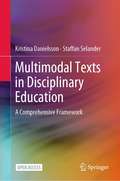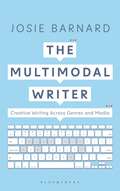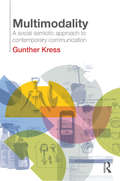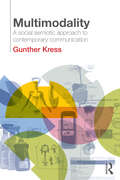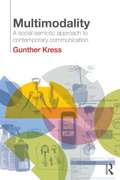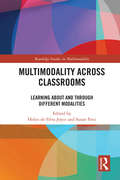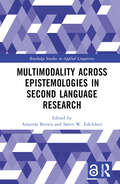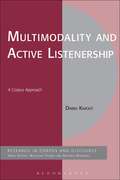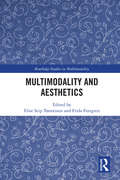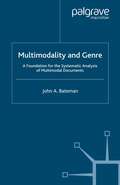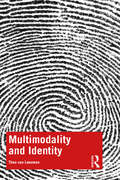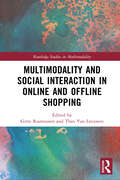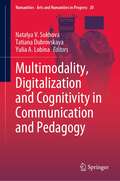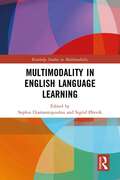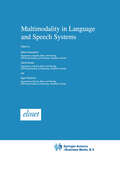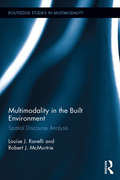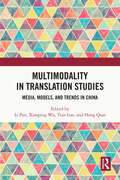- Table View
- List View
Multimodal Texts in Disciplinary Education: A Comprehensive Framework
by Kristina Danielsson Staffan SelanderThis open access book provides an introduction to multimodality and the role of multimodal texts in today’s education. Presenting a comprehensive framework for analysing and working with multimodal texts in disciplinary education, it serves as a tool for researchers and teachers alike. The second part of the book focuses on sample analyses of a variety of educational texts for different age groups and from different disciplines, including games and online resources. The authors also comment on the specific challenges of each text, and how teachers can discuss such texts with their students to enhance both their understanding of the content and their multimodal literacy. The book is intended for researchers in fields like education and multimodal studies, and for teacher educators, regardless of school subject or age group. With the combined perspectives on text analysis and implications for education, the book addresses the needs of teachers who want to work with multimodal aspects of texts in education in informed ways, but lack the right tools for such work.
The Multimodal Writer: Creative Writing Across Genres and Media
by Josie BarnardThese are exciting times for creative writing. In a digital age, the ability to move between types of writing and technologies - often at speed - is increasingly essential for writers. Yet, such flexibility can be difficult to achieve, and, how to develop it remains a pressing challenge. The Multimodal Writer combines theory, practitioner case studies and insightful writing exercises to support writers tackling the challenges and embracing the opportunities that come with new media technologies. Including interviews with a selection of internationally acclaimed authors, such as Simon Armitage, Robert Coover and Rhianna Pratchett, this book equips writers with the tools to not just survive but, rather, thrive in an era characterised by fast-paced change. With its focus on writing across genres, modes and media, this book is ideal for students of Creative Writing, Professional Writing, Media Writing and Journalism.
Multimodality: A Social Semiotic Approach to Contemporary Communication
by Gunther KressThe 21st century is awash with ever more mixed and remixed images, writing, layout, sound, gesture, speech, and 3D objects. Multimodality looks beyond language and examines these multiple modes of communication and meaning making. Multimodality: A Social Semiotic Approach to Contemporary Communication represents a long-awaited and much anticipated addition to the study of multimodality from the scholar who pioneered and continues to play a decisive role in shaping the field. Written in an accessible manner and illustrated with a wealth of photos and illustrations to clearly demonstrate the points made, Multimodality: A Social Semiotic Approach to Contemporary Communication deliberately sets out to locate communication in the everyday, covering topics and issues not usually discussed in books of this kind, from traffic signs to mobile phones. In this book, Gunther Kress presents a contemporary, distinctive and widely applicable approach to communication. He provides the framework necessary for understanding the attempt to bring all modes of meaning-making together under one unified theoretical roof. This exploration of an increasingly vital area of language and communication studies will be of interest to advanced undergraduate and postgraduate students in the fields of English language and applied linguistics, media and communication studies and education.
Multimodality: A Social Semiotic Approach to Contemporary Communication
by Gunther KressThe 21st century is awash with ever more mixed and remixed images, writing, layout, sound, gesture, speech, and 3D objects. Multimodality looks beyond language and examines these multiple modes of communication and meaning making. Multimodality: A Social Semiotic Approach to Contemporary Communication represents a long-awaited and much anticipated addition to the study of multimodality from the scholar who pioneered and continues to play a decisive role in shaping the field. Written in an accessible manner and illustrated with a wealth of photos and illustrations to clearly demonstrate the points made, Multimodality: A Social Semiotic Approach to Contemporary Communication deliberately sets out to locate communication in the everyday, covering topics and issues not usually discussed in books of this kind, from traffic signs to mobile phones. In this book, Gunther Kress presents a contemporary, distinctive and widely applicable approach to communication. He provides the framework necessary for understanding the attempt to bring all modes of meaning-making together under one unified theoretical roof. This exploration of an increasingly vital area of language and communication studies will be of interest to advanced undergraduate and postgraduate students in the fields of English language and applied linguistics, media and communication studies and education.
Multimodality: Exploring Contemporary Methods of Communication (PDF)
by Gunther R. KressThe 21st century is awash with ever more mixed and remixed images, writing, layout, sound, gesture, speech, and 3D objects.nbsp;Multimodality looks beyond language and examines these multiple modes of communication and meaning making.
Multimodality Across Classrooms: Learning About and Through Different Modalities (Routledge Studies in Multimodality)
by Helen De Silva Joyce Susan FeezThis volume takes a broad view of multimodality as it applies to a wide range of subject areas, curriculum design, and classroom processes to examine the ways in which multiple modes combine in contemporary classrooms and its subsequent impact on student learning. Grounded in a systemic functional linguistic framework and featuring contributions from scholars across educational and multimodal research, the book begins with a historical overview of multimodality’s place in Western education and then moves to a discussion of the challenges and rewards of integrating multimodal texts and ever-evolving technologies in a variety of settings, include primary, language, music, early childhood, Montessori, and online classrooms. As a state of the art of teaching and learning through different modalities in different educational contexts, this book is an indispensable resource for students and scholars in applied linguistics, multimodality, and language education.
Multimodality Across Classrooms: Learning About and Through Different Modalities (Routledge Studies in Multimodality)
by Helen De Silva Joyce Susan FeezThis volume takes a broad view of multimodality as it applies to a wide range of subject areas, curriculum design, and classroom processes to examine the ways in which multiple modes combine in contemporary classrooms and its subsequent impact on student learning. Grounded in a systemic functional linguistic framework and featuring contributions from scholars across educational and multimodal research, the book begins with a historical overview of multimodality’s place in Western education and then moves to a discussion of the challenges and rewards of integrating multimodal texts and ever-evolving technologies in a variety of settings, include primary, language, music, early childhood, Montessori, and online classrooms. As a state of the art of teaching and learning through different modalities in different educational contexts, this book is an indispensable resource for students and scholars in applied linguistics, multimodality, and language education.
Multimodality across Epistemologies in Second Language Research (Routledge Studies in Applied Linguistics)
by Amanda Brown and Søren W. EskildsenThis collection highlights diverse epistemological perspectives in original research on the important role of multimodality in second language contexts. The volume explores a wide range of theoretical and methodological traditions toward foregrounding the notion that bodily action is not merely an add-on to the modality of talk but an integral part of second language teaching, learning, and interaction. Following an introductory chapter, 18 empirical chapters feature either classroom or non-classroom research, which shed light on different dimensions of multimodality in second language contexts, including learning reflected in gesture, learning gesture across languages, the role of bodily action in language teaching, and the role of movement in configuring space for effective communication. Each empirical chapter follows a consistent structure detailing the research focus, the background to each study, methodology, and findings. A concluding synthesis chapter braids the insights of these chapters, drawing parallels across different methods, and pointing toward crosscutting areas for future research. This book will be of interest to students and scholars in applied linguistics, multilingualism, bilingualism, gesture studies, cognitive science, and psychology.Chapter 10 of this book is available for free in PDF format as Open Access at www.taylorfrancis.com. It has been made available under a Creative Commons Attribution-NonCommercial-ShareAlike (CC-BY-NC-SA) 4.0 International license.
Multimodality across Epistemologies in Second Language Research (Routledge Studies in Applied Linguistics)
This collection highlights diverse epistemological perspectives in original research on the important role of multimodality in second language contexts. The volume explores a wide range of theoretical and methodological traditions toward foregrounding the notion that bodily action is not merely an add-on to the modality of talk but an integral part of second language teaching, learning, and interaction. Following an introductory chapter, 18 empirical chapters feature either classroom or non-classroom research, which shed light on different dimensions of multimodality in second language contexts, including learning reflected in gesture, learning gesture across languages, the role of bodily action in language teaching, and the role of movement in configuring space for effective communication. Each empirical chapter follows a consistent structure detailing the research focus, the background to each study, methodology, and findings. A concluding synthesis chapter braids the insights of these chapters, drawing parallels across different methods, and pointing toward crosscutting areas for future research. This book will be of interest to students and scholars in applied linguistics, multilingualism, bilingualism, gesture studies, cognitive science, and psychology.Chapter 10 of this book is available for free in PDF format as Open Access at www.taylorfrancis.com. It has been made available under a Creative Commons Attribution-NonCommercial-ShareAlike (CC-BY-NC-SA) 4.0 International license.
Multimodality and Active Listenership: A Corpus Approach (Corpus and Discourse)
by Dawn KnightCurrent corpora are invaluable resources for generating accurate and objective analyses of patterns of language use. However, spoken corpora are effectively mono-modal, presenting data in the same physical medium – text. The reality of a discourse situation is lost in its representation as text. Using multimodal data sets when conducting corpus-based pragmatic analyses is one solution. This book looks at multimodal corpora in some depth, using backchanneling as the conversational feature to be analysed. It provides a bottom-up investigation of the issues and challenges faced at every stage of multimodal corpus construction and analysis, as well as providing an in-depth linguistic analysis of a cross section of multimodal corpus data. The collaborative and co-operative nature of backchannels is highlighted in this book and an adapted pragmatic-functional linguistic coding matrix for the characterisation of backchanneling phenomena is presented. Dawn Knight also looks at possible directions in the construction and use of multimodal corpus linguistics.
Multimodality and Active Listenership: A Corpus Approach (Corpus and Discourse)
by Dawn KnightCurrent corpora are invaluable resources for generating accurate and objective analyses of patterns of language use. However, spoken corpora are effectively mono-modal, presenting data in the same physical medium – text. The reality of a discourse situation is lost in its representation as text. Using multimodal data sets when conducting corpus-based pragmatic analyses is one solution. This book looks at multimodal corpora in some depth, using backchanneling as the conversational feature to be analysed. It provides a bottom-up investigation of the issues and challenges faced at every stage of multimodal corpus construction and analysis, as well as providing an in-depth linguistic analysis of a cross section of multimodal corpus data. The collaborative and co-operative nature of backchannels is highlighted in this book and an adapted pragmatic-functional linguistic coding matrix for the characterisation of backchanneling phenomena is presented. Dawn Knight also looks at possible directions in the construction and use of multimodal corpus linguistics.
Multimodality and Aesthetics (Routledge Studies in Multimodality)
by Elise Seip Tønnessen Frida ForsgrenThis volume explores the relationship between aesthetics and traditional multimodal communication to show how all semiotic resources, not just those situated within fine arts, have an aesthetic function. Bringing together contributions from an interdisciplinary group of researchers, the book meditates on the role of aesthetics in a broader range of semiotic resources, including urban spaces, blogs, digital scrapbooks, children’s literature, music, and online learning environments. The result is a comprehensive collection of new perspectives on how communication and aesthetics enrich and complement one another when meaning is made with semiotic resources, making this key reading for students and scholars in multimodality, fine arts, education studies, and visual culture.
Multimodality and Aesthetics (Routledge Studies in Multimodality)
by Elise Seip Tønnessen Frida ForsgrenThis volume explores the relationship between aesthetics and traditional multimodal communication to show how all semiotic resources, not just those situated within fine arts, have an aesthetic function. Bringing together contributions from an interdisciplinary group of researchers, the book meditates on the role of aesthetics in a broader range of semiotic resources, including urban spaces, blogs, digital scrapbooks, children’s literature, music, and online learning environments. The result is a comprehensive collection of new perspectives on how communication and aesthetics enrich and complement one another when meaning is made with semiotic resources, making this key reading for students and scholars in multimodality, fine arts, education studies, and visual culture.
Multimodality and Genre: A Foundation for the Systematic Analysis of Multimodal Documents
by J. BatemanThe first systematic, corpus-based and theoretically rigorous approach to the description and analysis of multimodal documents. Drawing on academic research and the experience of designers and production teams, Bateman uses linguistically-based analysis to show how different modes of expression together make up a document with a recognisable genre.
Multimodality and Identity
by Theo van LeeuwenThis book brings together the work of leading theorist, Theo van Leeuwen, on typography, colour, texture, sound and movement, and shows how they are used to communicate identity, both corporate and individual. The book provides a detailed approach to analysing the key elements of multimodal style, and shows how these can be applied to a wide range of domains, including typography, product design, architecture, and animation films. Combining sociological insights into contemporary forms of identity with multimodal approaches to analysing how these identities are expressed, the text is richly illustrated with examples from fashion, the built environment, logos, modern art and more. With sample analyses, this user-friendly text provides clear methods for analysis and creative strategies for the practice of multimodal communication. Providing an invaluable toolkit to analysing the key elements of multimodal design and the way they work together, this book is essential reading for students, teachers and researchers in the field of multimodal communication, whether in communication studies, linguistics, design studies, media studies or the arts.
Multimodality and Identity
by Theo van LeeuwenThis book brings together the work of leading theorist, Theo van Leeuwen, on typography, colour, texture, sound and movement, and shows how they are used to communicate identity, both corporate and individual. The book provides a detailed approach to analysing the key elements of multimodal style, and shows how these can be applied to a wide range of domains, including typography, product design, architecture, and animation films. Combining sociological insights into contemporary forms of identity with multimodal approaches to analysing how these identities are expressed, the text is richly illustrated with examples from fashion, the built environment, logos, modern art and more. With sample analyses, this user-friendly text provides clear methods for analysis and creative strategies for the practice of multimodal communication. Providing an invaluable toolkit to analysing the key elements of multimodal design and the way they work together, this book is essential reading for students, teachers and researchers in the field of multimodal communication, whether in communication studies, linguistics, design studies, media studies or the arts.
Multimodality and Social Interaction in Online and Offline Shopping (Routledge Studies in Multimodality)
by Gitte Rasmussen Theo van LeeuwenThis collection brings together social semiotic, ethnographic, and conversation analytic approaches to multimodality in global studies of shopping, drawing on the rich diversity of the latest multimodal methods to critically reflect on shopping as a cornerstone of contemporary social life.The volume explores shopping as an area of study in its own right, with the buying and selling of goods and services a fundamental part of the social and cultural life of human communities for centuries. The book looks at both online and offline shopping, examining it as both everyday multi-sensorial practice and its translation into the interactive text and imagery that comprise the online shopping experience, from London street markets to Japanese grocery shops to Danish supermarkets to worldwide online shopping sites. Highlighting the diversity of modern multimodal approaches through contributions from established scholars, the book critically surveys both the challenges and opportunities in the embodied interactions between buyers and sellers and how these points of connection have been translated and will continue to transform in the age of algorithms and emergent technologies.This book will appeal to students and scholars interested in multimodality, multimodal conversation analysis, social semiotics, social interaction, and retail studies.
Multimodality and Social Interaction in Online and Offline Shopping (Routledge Studies in Multimodality)
This collection brings together social semiotic, ethnographic, and conversation analytic approaches to multimodality in global studies of shopping, drawing on the rich diversity of the latest multimodal methods to critically reflect on shopping as a cornerstone of contemporary social life.The volume explores shopping as an area of study in its own right, with the buying and selling of goods and services a fundamental part of the social and cultural life of human communities for centuries. The book looks at both online and offline shopping, examining it as both everyday multi-sensorial practice and its translation into the interactive text and imagery that comprise the online shopping experience, from London street markets to Japanese grocery shops to Danish supermarkets to worldwide online shopping sites. Highlighting the diversity of modern multimodal approaches through contributions from established scholars, the book critically surveys both the challenges and opportunities in the embodied interactions between buyers and sellers and how these points of connection have been translated and will continue to transform in the age of algorithms and emergent technologies.This book will appeal to students and scholars interested in multimodality, multimodal conversation analysis, social semiotics, social interaction, and retail studies.
Multimodality, Digitalization and Cognitivity in Communication and Pedagogy (Numanities - Arts and Humanities in Progress #20)
by Natalya V. Sukhova Tatiana Dubrovskaya Yulia A. LobinaThis book positions itself at the intersection of the key areas of the modern humanities. Different authors from a variety of countries take innovative approaches to investigating multimodal communication, adapting pedagogical design to digital environments and enhancing cognitive skills through transformations in teaching and learning practices. The eclectic forms under study require eclectic approaches and methodologies, and the authors cross disciplinary boundaries drawing on philosophy, linguistics, semiotics, computational linguistics, mathematics, cognitive studies and neuroaesthetics. Part I presents methods of analysing multimodal communication in its different displays, covering promotional video in crowdfunding project presentations, multimodal public signs of prohibition and visuals as arguments. Part II explores varied teaching methodologies that have emerged as a result of and in response to modern technological changes and contains some practical hints for educators. It demonstrates the pedagogical potential of video games, virtual worlds, linguistic corpora and online dictionaries. Part III focuses on psychological and cognitive factors influencing success in the classroom, primarily, ways of developing students’ and teachers’ personalities. The volume sits at the intersection between Communication Studies, Digital Humanities, Discourse Analysis, Education Theory and Cognitive Studies and is useful to scholars and students of communication, languages, education and other areas of the humanities. This book should trigger scholarly discussions as well as stimulating practitioners’ interest in these fields.
Multimodality in English Language Learning (Routledge Studies in Multimodality)
by Sophia DiamantopoulouThis edited volume provides research-based knowledge on the use, production and assessment of multimodal texts in the teaching and learning of English as an Additional Language (EAL). The book reflects growing interest in research on EAL, with increasing numbers of learners of English worldwide and the growing relevance of EAL to numerous education systems. The volume examines different aspects of English from a multimodal perspective, showcasing empirical research from across five continents and all three levels of education. Applying frameworks based on Multimodal Social Semiotics and Systemic Functional Linguistics, chapters focus on the use and affordances of multimodal texts in pedagogy, literature, culture, text production, assessment and curriculum development connected to EAL. Directing attention to the significance of modes beyond speech and writing in EAL, the volume provides a wide range of perspectives and experiences that can be applied more widely and inspire other practices in the global and diverse field of EAL teaching, learning and assessment. This collection will be of interest to scholars in multimodality, language education, and teacher education.
Multimodality in English Language Learning (Routledge Studies in Multimodality)
by Sophia Diamantopoulou Sigrid ØrevikThis edited volume provides research-based knowledge on the use, production and assessment of multimodal texts in the teaching and learning of English as an Additional Language (EAL). The book reflects growing interest in research on EAL, with increasing numbers of learners of English worldwide and the growing relevance of EAL to numerous education systems. The volume examines different aspects of English from a multimodal perspective, showcasing empirical research from across five continents and all three levels of education. Applying frameworks based on Multimodal Social Semiotics and Systemic Functional Linguistics, chapters focus on the use and affordances of multimodal texts in pedagogy, literature, culture, text production, assessment and curriculum development connected to EAL. Directing attention to the significance of modes beyond speech and writing in EAL, the volume provides a wide range of perspectives and experiences that can be applied more widely and inspire other practices in the global and diverse field of EAL teaching, learning and assessment. This collection will be of interest to scholars in multimodality, language education, and teacher education.
Multimodality in Language and Speech Systems (Text, Speech and Language Technology #19)
by Nancy IdeThis book is based on contributions to the Seventh European Summer School on Language and Speech Communication that was held at KTH in Stockholm, Sweden, in July of 1999 under the auspices of the European Language and Speech Network (ELSNET). The topic of the summer school was "Multimodality in Language and Speech Systems" (MiLaSS). The issue of multimodality in interpersonal, face-to-face communication has been an important research topic for a number of years. With the increasing sophistication of computer-based interactive systems using language and speech, the topic of multimodal interaction has received renewed interest both in terms of human-human interaction and human-machine interaction. Nine lecturers contri buted to the summer school with courses on specialized topics ranging from the technology and science of creating talking faces to human-human communication, which is mediated by computer for the handicapped. Eight of the nine lecturers are represented in this book. The summer school attracted more than 60 participants from Europe, Asia and North America representing not only graduate students but also senior researchers from both academia and industry.
Multimodality in the Built Environment: Spatial Discourse Analysis (Routledge Studies in Multimodality)
by Louise J. Ravelli Robert J. McMurtrieThis book provides an extended exploration of the multimodal analysis of spatial (three-dimensional) texts of the built environment, culminating in a holistic approach termed Spatial Discourse Analysis (SpDA). Based on existing frameworks of multimodal analysis, this book applies, adapts, and extends these frameworks to spatial texts. The authors argue that choices in spatial design create meanings about what we perceive and how we can or should behave within spatial texts, influence how we feel in and about those spaces, and enable these texts to function as coherent wholes. Importantly, a spatial text, once built, is also a resource which is then used, and an essential aspect of understanding these texts is to consider what users themselves contribute to the meaning potential of these texts. The book takes the metafunctional approach familiar from Systemic-Functional Linguistics (SFL) and foregrounds each metafunction in turn (textual, interpersonal, experiential, and logical), in relation to the detailed analysis of a particular spatial text.
Multimodality in the Built Environment: Spatial Discourse Analysis (Routledge Studies in Multimodality)
by Louise J. Ravelli Robert J. McMurtrieThis book provides an extended exploration of the multimodal analysis of spatial (three-dimensional) texts of the built environment, culminating in a holistic approach termed Spatial Discourse Analysis (SpDA). Based on existing frameworks of multimodal analysis, this book applies, adapts, and extends these frameworks to spatial texts. The authors argue that choices in spatial design create meanings about what we perceive and how we can or should behave within spatial texts, influence how we feel in and about those spaces, and enable these texts to function as coherent wholes. Importantly, a spatial text, once built, is also a resource which is then used, and an essential aspect of understanding these texts is to consider what users themselves contribute to the meaning potential of these texts. The book takes the metafunctional approach familiar from Systemic-Functional Linguistics (SFL) and foregrounds each metafunction in turn (textual, interpersonal, experiential, and logical), in relation to the detailed analysis of a particular spatial text.
Multimodality in Translation Studies: Media, Models, and Trends in China
by Li Pan Xiaoping Wu Tian Luo Hong QianFocusing on multimodality in translation studies, this edited volume provides insights into the trends and practices of multimodal translation in a variety of media. Divided into four main themes, the book explores audiovisual translation in digital media, multimodal translation of Chinese classics, multimodal design in website translation, and the use of paratexts in conference interpreting. Contributors draw on a diverse range of methods and theoretical models, including systemic functional multimodal discourse analysis, narrative theory, Skopos-functional theory, multimodal analysis of digital discourse, and corpus-based multimodal analysis. It covers important topics in media translation, ranging from emerging multimodal translation models to multimodal creativity in interlingual subtitling for social media and identity construction in the multimodal translation of food advertising. Through robust empirical studies, the book aims to shed light on the methodological development of multimodal translation in different media forms, including social media, websites, on-site interactions and books. The title will be of great value to scholars and students of linguistics, translation studies, multimodal discourse analysis and digital media.
